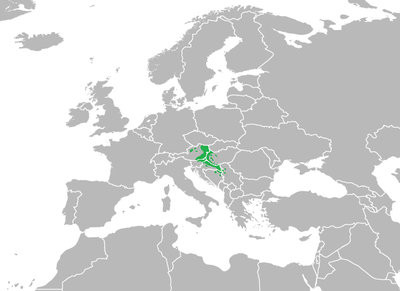Austman: Difference between revisions
No edit summary |
No edit summary |
||
| Line 26: | Line 26: | ||
Since the independence of Austria from the Ottoman Empire in 1881, Austman has been largely rendered under the shadow of Standard German, and until 1922, did not hold any official status in the country. However, unlike other so-called "High German dialects", Austman has maintained a strong speaker base inspite of the social ubiquity of Standard German, remaining the primary language of eastern cities like Graz. This is primarily due to the massive level of divergence coupled with social separation of the Austmans due to their adherence to Islam as opposed to the majority Catholic religion of the Austrian Germans. | Since the independence of Austria from the Ottoman Empire in 1881, Austman has been largely rendered under the shadow of Standard German, and until 1922, did not hold any official status in the country. However, unlike other so-called "High German dialects", Austman has maintained a strong speaker base inspite of the social ubiquity of Standard German, remaining the primary language of eastern cities like Graz. This is primarily due to the massive level of divergence coupled with social separation of the Austmans due to their adherence to Islam as opposed to the majority Catholic religion of the Austrian Germans. | ||
==External History== | |||
Austman belongs to an alternate history timeline where the Austrian and Hungarian Kingdoms were conquered by and integrated into the Ottoman Empire. The languge is descended from a hypothetical Austro-Bavarian dialect spoken in Eastern Austria, with a significant input from Turkish, Arabic, and Persian superstrata, as well as lesser input from South Slavic and Hungarian constrata. Austman's intended goal is to attempt to create a language for an Islamic German culture that could reasonably have formed. | |||
==General Information== | |||
===Classification=== | |||
Austman is classified as belonging to the High German dialect continuum, falling squarely within the upper High German dialects, specifically the Austro-Bavarian group. Despite eventually becoming the main variation of the German language to be spoken within Vienna, the dialect did not, in fact, originate around Vienna, but rather around the south of the country. The spread of Austman and subsequent breaking into various dialects has resulted in a disruption of the original High German dialect continuum in Austria and beyond, leading to some uncertainty as to where exactly in Austria the dialect originated, though it is strongly suggested that it formed in [[w:styria|Styria]] due to its strength around the city of Graz, and northward progression throughout history. | |||
Revision as of 21:21, 25 August 2018
| Austman | |
|---|---|
| دیچ Dîç | |
 | |
| Pronunciation | [/diːt͡ʃ/] |
| Created by | Karous |
| Native speakers | 2,916,000 (2000) |
Standard form | Viennese Language
|
Austman (دیچ [diːt͡ʃ] Dîç) is a West Germanic language belonging to the Upper German group, spoken in the southeast of the Republic of Austria down through the Pannonian Basin following the path of the Danube River through southeast Europe into Hungary and northern Bosnia and Herzegovina.
Since the independence of Austria from the Ottoman Empire in 1881, Austman has been largely rendered under the shadow of Standard German, and until 1922, did not hold any official status in the country. However, unlike other so-called "High German dialects", Austman has maintained a strong speaker base inspite of the social ubiquity of Standard German, remaining the primary language of eastern cities like Graz. This is primarily due to the massive level of divergence coupled with social separation of the Austmans due to their adherence to Islam as opposed to the majority Catholic religion of the Austrian Germans.
External History
Austman belongs to an alternate history timeline where the Austrian and Hungarian Kingdoms were conquered by and integrated into the Ottoman Empire. The languge is descended from a hypothetical Austro-Bavarian dialect spoken in Eastern Austria, with a significant input from Turkish, Arabic, and Persian superstrata, as well as lesser input from South Slavic and Hungarian constrata. Austman's intended goal is to attempt to create a language for an Islamic German culture that could reasonably have formed.
General Information
Classification
Austman is classified as belonging to the High German dialect continuum, falling squarely within the upper High German dialects, specifically the Austro-Bavarian group. Despite eventually becoming the main variation of the German language to be spoken within Vienna, the dialect did not, in fact, originate around Vienna, but rather around the south of the country. The spread of Austman and subsequent breaking into various dialects has resulted in a disruption of the original High German dialect continuum in Austria and beyond, leading to some uncertainty as to where exactly in Austria the dialect originated, though it is strongly suggested that it formed in Styria due to its strength around the city of Graz, and northward progression throughout history.